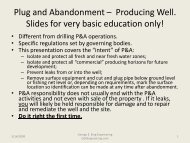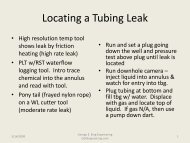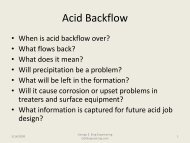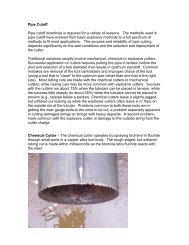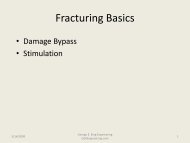III.<strong>Environmental</strong> <strong>Risks</strong> and Best Practices<strong>Shale</strong> gas has received a good deal of attention recently for <strong>the</strong> potential negative impacts that itsdevelopment may have on <strong>the</strong> environments and communities in which it occurs. Instances ofwater contamination, air pollution, and earthquakes have been blamed on gas extractionactivities. A thorough understanding of <strong>the</strong> techniques used to extract gas <strong>from</strong> shale formationsand <strong>the</strong> safeguards that exist to prevent environmental damage is critical to assessing <strong>the</strong> sourcesand magnitudes of risk involved in shale gas development.Subsurface Contamination of Ground WaterA frequently expressed concern about shale gas development is that subsurface hydraulicfracturing operations in deep shale formations might create fractures that extend well beyond <strong>the</strong>target formation to water aquifers, allowing methane, contaminants naturally occurring information water, and fracturing fluids to migrate <strong>from</strong> <strong>the</strong> target formation into drinking watersupplies. With <strong>the</strong> notable exceptions of <strong>the</strong> shallow Antrim and New Albany <strong>Shale</strong>s, manythousands of feet of rock separate most major gas-bearing shale formations in <strong>the</strong> United States<strong>from</strong> <strong>the</strong> base of aquifers that contain drinkable water. 18 (See Figure 5.)Figure 5. Target <strong>Shale</strong> Depth and Base of Treatable Groundwater in Select <strong>Shale</strong> PlaysSource: GWPCBecause <strong>the</strong> direct contamination of underground sources of drinking water <strong>from</strong> fracturescreated by hydraulic fracturing would require hydrofractures to propagate several thousand feet7
eyond <strong>the</strong> upward boundary of <strong>the</strong> target formation through many layers of rock, suchcontamination is highly unlikely to occur in deep shale formations during well-designed fracturejobs. For example, <strong>the</strong> top of <strong>the</strong> Marcellus <strong>Shale</strong>, which runs <strong>from</strong> upstate New York throughPennsylvania, West Virginia, and parts of Ohio, lies <strong>from</strong> 4,000 to 8,500 feet below <strong>the</strong> surface. 19The deepest underground sources of drinking water in this region lie about 850 feet below <strong>the</strong>surface. 20 Geologists estimate that <strong>the</strong>re is at least a half mile of rock between <strong>the</strong> natural gasdeposits and <strong>the</strong> groundwater, including nine layers of impermeable shale, each of which acts asa barrier to vertical propagation of both natural and artificial fractures. 21As mentioned earlier, seismic monitoring is an essential tool for assuring that hydraulicfracturing is inducing microseismic activity only within <strong>the</strong> shale gas reservoir. Yet only aboutthree percent of <strong>the</strong> ~75,000 hydraulic fracturing stages conducted in <strong>the</strong> United States in 2009were seismically monitored. 22 Public confidence in <strong>the</strong> safety of hydraulic fracturing would begreatly improved by more frequent microseismic monitoring and public dissemination of <strong>the</strong>results.Failure of <strong>the</strong> cement or casing surrounding <strong>the</strong> wellbore poses a far greater risk to watersupplies. If <strong>the</strong> annulus is improperly sealed, natural gas, fracturing fluids, and formation watercontaining high concentrations of dissolved solids may be communicated directly along <strong>the</strong>outside of <strong>the</strong> wellbore among <strong>the</strong> target formation, drinking water aquifers, and layers of rock inbetween. For example, in 2007, a well that had been drilled almost 4,000 feet into a tight sandformation in Bainbridge, Ohio was not properly sealed with cement, allowing gas <strong>from</strong> a shalelayer above <strong>the</strong> target tight sand formation to travel through <strong>the</strong> annulus into an undergroundsource of drinking water. The methane eventually built up until an explosion in a resident‘sbasement alerted state officials to <strong>the</strong> problem. 23A variety of tools exist to help producers and regulators minimize <strong>the</strong> risk of cement and casingfailures. The American Petroleum Institute (API) develops and updates standards and―recommended practices‖ for oil and gas exploration and production activities. 24 Many stateregulations require steel casing and cement used in oil and gas well construction to meetstandards set by API or o<strong>the</strong>r organizations. 25 Frequent monitoring and testing also allowproducers and regulators to check <strong>the</strong> integrity of casing and cement jobs. Many states requireoperators to perform a test such as a cement bond log, which measures <strong>the</strong> quality of <strong>the</strong> cementcasingand cement-formation bonds. 26 Ensuring that <strong>the</strong>se tests are conducted and heeded inaccordance with regulations, and requiring <strong>the</strong>m in states where <strong>the</strong>y are currently voluntary, areessential to preventing accidents such as occurred in Bainbridge.BlowoutsRecent gas well blowouts in Pennsylvania and West Virginia during drilling operations in <strong>the</strong>Marcellus <strong>Shale</strong>, set against <strong>the</strong> backdrop of <strong>the</strong> recent offshore blowout and oil spill in <strong>the</strong> Gulfof Mexico, underscore <strong>the</strong> environmental and public risks associated with drilling into highlypressurized zones of hydrocarbons and introducing pressurized fluids during hydraulicfracturing. 27 At <strong>the</strong> time of writing this article, <strong>the</strong> causes of all three blowouts were still underinvestigation. Operators in Pennsylvania reported that that blowout occurred because <strong>the</strong> blowoutpreventer proved inadequate to deal with higher-than-anticipated pressures. 28 In West Virginia,8






